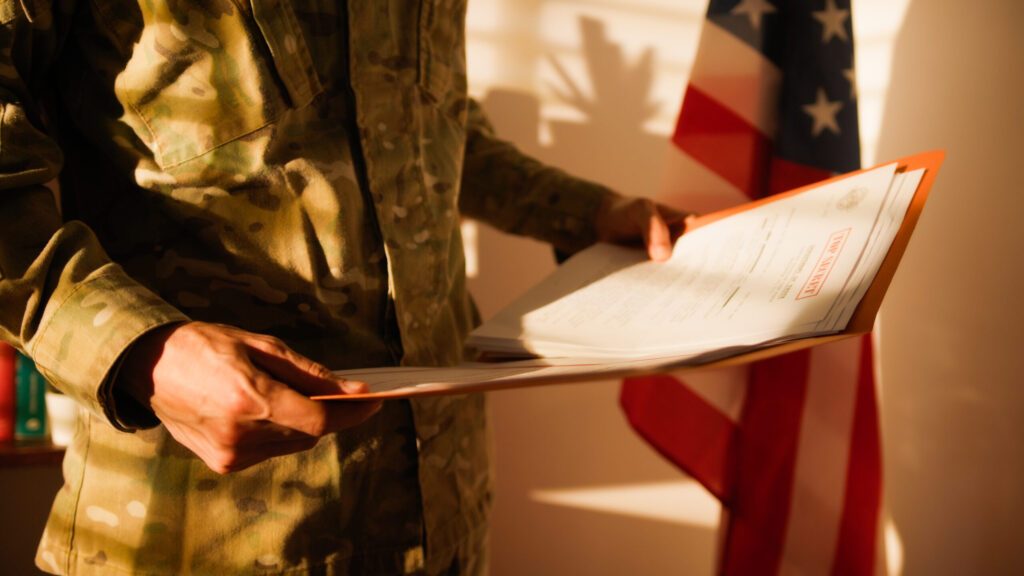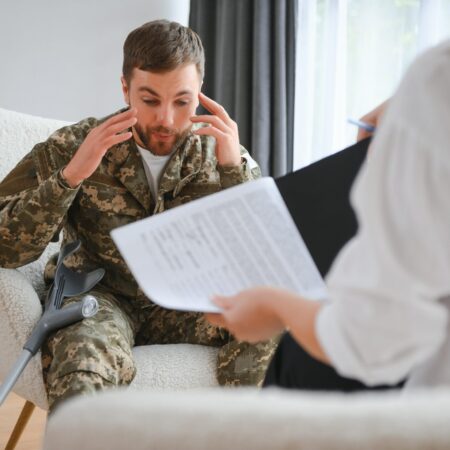Veteran Law

Overview:
At Marple Law, we endeavor to provide thorough and professional veterans advocacy and representation. We are dedicated to serving those who have bravely served our country by providing professional legal assistance and unwavering support in securing the benefits and recognition you deserve. Whether you are navigating the complexities of disability claims, appealing denied benefits, or seeking discharge upgrades, James Marple is here to guide you through every step of the process. At Marple Law, we honor your service by fiercely advocating for your rights and ensuring you receive the full spectrum of benefits owed to you.
Information on the Review Process
The VA disability rating process begins when a veteran submits a claim for compensation, including all relevant medical records and supporting documentation of their service-connected condition. Upon receipt, the VA reviews the claim, often scheduling a Compensation and Pension (C&P) exam to evaluate the severity of the condition. The VA then applies the VA Schedule for Rating Disabilities (VASRD) to determine the appropriate percentage rating, reflecting the level of impairment and its impact on the veteran’s daily life and ability to work. Once the rating is assigned, the veteran receives a notification letter detailing the decision, including the assigned percentage and the reasons behind it. If the veteran disagrees with the rating, they can appeal the decision through various channels, such as requesting a Higher-Level Review, submitting a Supplemental Claim with new evidence, or appealing to the Board of Veterans’ Appeals (BVA) for a thorough review. Throughout this process, veterans may benefit from the assistance of an experienced attorney or advocate to ensure their case is accurately presented and to maximize their chances of receiving the appropriate compensation.

Potential Appeal Options
Requesting a Higher-Level Review with the Department of Veterans Affairs (VA) is an option available to veterans who are dissatisfied with a decision on their claim for benefits. This process involves a senior claims adjudicator reviewing the original decision to determine if an error was made or if additional evidence or a different interpretation of the existing evidence could change the outcome. Here’s a detailed overview of the process:
-
- Eligibility: To request a Higher-Level Review, the veteran must have received a decision on their claim from the VA. This review must be requested within one year of the date on the original decision notice.
-
- Filing the Request: The veteran must complete and submit VA Form 20-0996, "Decision Review Request: Higher-Level Review." This form can be submitted online through the VA's eBenefits portal, by mail, or in person at a VA regional office.
-
- No New Evidence: The Higher-Level Review process does not allow for the submission of new evidence. The review is based solely on the evidence already in the veteran’s file. However, veterans can request an informal conference with the reviewer to identify specific errors in the original decision or highlight aspects of the existing evidence that may have been overlooked or misinterpreted.
-
- Review Process: A more experienced VA employee, who was not involved in the original decision, conducts the Higher-Level Review. This senior reviewer reexamines the case and considers whether the initial decision was made correctly based on the evidence and applicable laws and regulations.
-
- Decision: After the review, the VA will issue a new decision. This could result in the same outcome, an increased or decreased benefit rating, or a different effective date for the benefits. The veteran will receive a notification letter explaining the decision and the reasons behind it.
-
- Further Appeals: If the veteran is still dissatisfied with the outcome of the Higher-Level Review, they can appeal to the Board of Veterans' Appeals. This process involves submitting a Notice of Disagreement (NOD) and can include submitting new evidence or requesting a hearing.
By requesting a Higher-Level Review, veterans have the opportunity to have their claims re-evaluated by a more experienced adjudicator, potentially leading to a more favorable outcome without the need to submit new evidence. This can be a crucial step for veterans seeking the benefits they rightfully deserve.
More Info: VA - Higher-Level Review
Appealing through the Supplemental Claim line is an option for veterans who wish to challenge a decision made by the Department of Veterans Affairs (VA) regarding their benefits. This process allows veterans to submit new and relevant evidence to support their claim. Here’s an overview of the process:
-
- Eligibility: Veterans can file a Supplemental Claim if they have new and relevant evidence that was not part of their original claim or prior decision. This evidence must provide additional information that could potentially change the VA’s decision on their claim.
-
- Filing the Supplemental Claim: The veteran must complete and submit VA Form 20-0995, "Decision Review Request: Supplemental Claim." This form can be submitted online through the VA's eBenefits portal, by mail, or in person at a VA regional office.
-
- New and Relevant Evidence: The key to a successful Supplemental Claim is the submission of new and relevant evidence. This could include medical records, statements from healthcare providers, or other documentation that was not previously considered. The evidence must be pertinent to the claim and have the potential to affect the decision.
-
- Review Process: Upon receiving the Supplemental Claim and new evidence, the VA will review the additional information alongside the veteran’s existing file. The review is conducted by the VA Claims Adjudication team, which reassesses the claim considering the new evidence provided.
-
- VA Decision: After reviewing the Supplemental Claim, the VA will issue a new decision. This decision may result in the approval of benefits, an increase or decrease in the rating, or the same denial as the original decision. The veteran will receive a notification letter explaining the decision and the evidence considered.
-
- Further Appeals: If the veteran remains dissatisfied with the decision on the Supplemental Claim, they have the option to further appeal to the Board of Veterans' Appeals by submitting a Notice of Disagreement (NOD). This can involve requesting a hearing and presenting additional evidence or arguments.
Appealing through the Supplemental Claim line provides veterans with a way to introduce new and relevant evidence to support their claim, offering a chance to correct or enhance their application without starting the entire claims process from scratch. This process helps ensure that veterans have multiple opportunities to secure the benefits they deserve by providing all pertinent information to the VA.
More Info: VA - Supplemental Claims
Appealing to the Board of Veterans' Appeals (BVA) is a process available to veterans who are dissatisfied with a decision made by the Department of Veterans Affairs (VA) on their claim for benefits. The BVA is an entity within the VA that conducts hearings and issues decisions on appeals. Here’s an overview of the process:
-
- Filing a Notice of Disagreement (NOD): To initiate an appeal to the BVA, the veteran must file a Notice of Disagreement (NOD) within one year from the date of the VA’s decision notice. This form, VA Form 10182, allows the veteran to formally disagree with the VA’s decision.
-
- Choosing the Type of Review: When filing the NOD, veterans can choose from three types of review:
-
- Direct Review: The BVA reviews the appeal based on the existing evidence without a hearing or additional evidence submission.
-
- Evidence Submission: The veteran can submit new evidence for consideration without a hearing.
- Hearing: The veteran can request a hearing before a Veterans Law Judge, with the option to submit new evidence.
-
- Choosing the Type of Review: When filing the NOD, veterans can choose from three types of review:
-
- Submitting the Appeal: The completed NOD can be submitted online through the VA’s eBenefits portal, by mail, or in person at a VA regional office. The veteran must specify the issues they are appealing and choose the type of review.
-
- Review and Decision Process:
-
- Direct Review: The BVA reviews the existing record and issues a decision based on the evidence already submitted.
-
- Evidence Submission: The BVA considers the new evidence submitted by the veteran in addition to the existing record.
- Hearing: The veteran has the opportunity to present their case in person, via videoconference, or in writing. The Veterans Law Judge will consider the hearing testimony along with the evidence.
-
- Review and Decision Process:
-
- BVA Decision: The BVA issues a written decision, which may grant, deny, or remand (send back) the claim for further development or reconsideration. The decision includes the reasons for the decision and the evidence considered.
-
- Further Appeals: If the veteran is dissatisfied with the BVA’s decision, they can appeal to the U.S. Court of Appeals for Veterans Claims (CAVC). This court reviews BVA decisions for legal errors. The appeal to the CAVC must be filed within 120 days of the BVA decision.
Appealing to the BVA provides veterans with an opportunity for a thorough review of their case by a higher authority within the VA. It ensures that their claims are carefully considered, and they have the chance to present new evidence or arguments to support their case. The BVA appeal process can be complex, so many veterans choose to seek assistance from legal representatives or veterans' service organizations to navigate it effectively.
More Info: VA - Board Appeals
Appealing to the U.S. Court of Appeals for Veterans Claims (CAVC) is the next step for veterans who are dissatisfied with a decision made by the Board of Veterans' Appeals (BVA). The CAVC is an independent federal court that reviews BVA decisions for legal errors. Here’s an overview of the process:
-
- Eligibility: To appeal to the CAVC, the veteran must have received a final decision from the BVA. The appeal must focus on errors of law or fact made by the BVA, rather than presenting new evidence.
-
- Filing the Appeal: The veteran must file a Notice of Appeal (NOA) with the CAVC within 120 days of the BVA’s decision date. The NOA can be submitted online, by mail, or in person at the CAVC. The filing fee must be paid unless the veteran qualifies for a fee waiver.
-
- Representation: Veterans have the right to represent themselves (pro se) or obtain legal representation. Many veterans choose to be represented by attorneys who specialize in veterans' law or by veterans' service organizations (VSOs).
-
- Record Before the Agency (RBA): Once the appeal is filed, the VA compiles the Record Before the Agency (RBA), which includes all documents and evidence considered by the BVA in making its decision. The veteran and their representative will review the RBA to identify any errors.
-
- Briefing: Both parties (the veteran/appellant and the VA/appellee) submit written briefs to the CAVC. These briefs outline the arguments and legal basis for the appeal, focusing on alleged errors in the BVA’s decision. The veteran’s brief typically highlights how the BVA misinterpreted the law, overlooked critical evidence, or failed to provide adequate reasons for its decision.
-
- Oral Argument: In some cases, the CAVC may hold an oral argument where attorneys for both parties present their cases and answer questions from the judges. However, most cases are decided based on the written briefs.
-
- Court Decision: The CAVC reviews the briefs, the RBA, and any oral arguments to make its decision. The court can:
-
- Affirm: Agree with the BVA’s decision and uphold it.
-
- Reverse: Overturn the BVA’s decision.
-
- Remand: Send the case back to the BVA for further action, often requiring the BVA to address errors or provide additional justification for its decision.
-
- Further Appeals: If either party is dissatisfied with the CAVC’s decision, they can appeal to the U.S. Court of Appeals for the Federal Circuit. Further appeals can also reach the U.S. Supreme Court, though this is rare.
- Court Decision: The CAVC reviews the briefs, the RBA, and any oral arguments to make its decision. The court can:
Appealing to the CAVC provides veterans with an opportunity for judicial review of the BVA’s decision, ensuring that legal standards are correctly applied, and veterans’ rights are protected. This process can be complex and technical, so many veterans seek experienced legal representation to navigate it effectively.
More Info: United States Court of Appeals for Veterans Claims
Disclaimer: The information provided on this page is for general informational purposes only. The inclusion of any links to external websites does not imply endorsement or affiliation. Marple Law is not responsible for the content or accuracy of any external sites you may visit through links on this page. Use external links at your own discretion and risk. For the most up-to-date information, please visit the organization’s official website.
Navigating the complex process of securing veterans’ benefits can be daunting and overwhelming. Retaining an experienced attorney can make a significant difference in successfully obtaining the benefits you rightfully deserve. At Marple Law, we understand the intricacies of veterans’ law and are equipped to handle the detailed paperwork, rigorous deadlines, and intricate legal arguments required to advocate effectively on your behalf. By enlisting our professional legal support, you can focus on your well-being while we ensure your claims are meticulously prepared and presented, increasing your chances of a favorable outcome. Don’t face this challenging journey alone—let us provide the guidance and dedicated representation you need.
VA Disability Rating Information
A VA disability rating is a percentage assigned by the Department of Veterans Affairs (VA) to a veteran’s service-connected disability or condition. This rating is determined based on the severity of the disability and its impact on the veteran’s ability to function in daily life, including work. The VA uses a standardized rating schedule, known as the VA Schedule for Rating Disabilities (VASRD), which evaluates various medical conditions and assigns a percentage rating from 0% to 100% in 10% increments.
The purpose of the disability rating is to quantify the degree of impairment and to provide a fair system for compensating veterans. A higher percentage indicates a more severe disability and a greater impact on the veteran’s life. For instance, a 10% rating might be assigned for a condition that has a minimal impact, while a 100% rating is reserved for disabilities that are completely disabling.
The assigned disability rating directly affects the amount of monthly compensation a veteran receives from the VA. This compensation is intended to offset the loss of earning capacity due to the disability. As of 2024, a veteran with a 10% rating might receive around $165 per month, while a veteran with a 100% rating could receive over $3,600 per month. Additionally, veterans with higher disability ratings may be eligible for additional benefits, such as healthcare, vocational rehabilitation, and dependent allowances.
Furthermore, the VA disability rating can influence other aspects of a veteran’s life. It may impact their eligibility for other VA benefits and programs, such as adaptive housing grants, education benefits, and special monthly compensation for severe disabilities requiring aid and attendance. The rating also plays a crucial role in determining the level of care and support services a veteran may access through the VA healthcare system.
Understanding the VA disability rating system is essential for veterans seeking compensation for service-connected conditions. Given the complexity of the rating process and its significant impact on a veteran’s financial and personal well-being, many veterans benefit from the assistance of an experienced attorney or veterans’ advocate. These professionals can help ensure that the veteran’s conditions are accurately assessed and that they receive the maximum benefits to which they are entitled.


